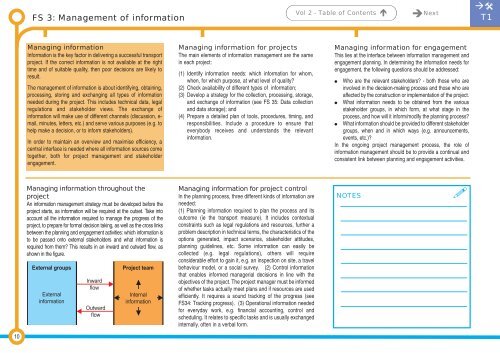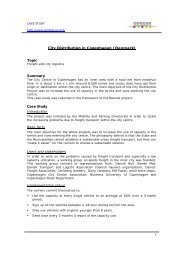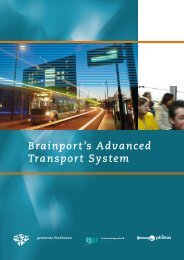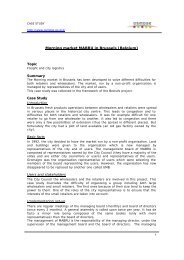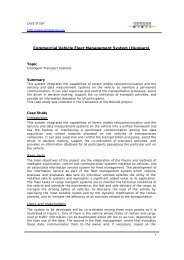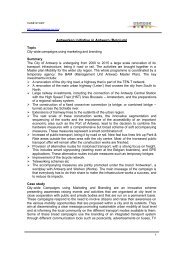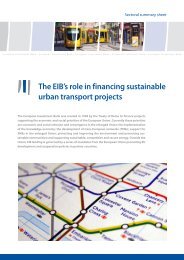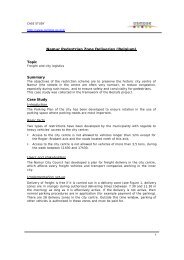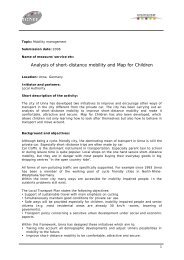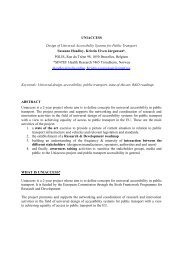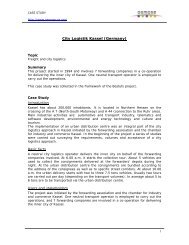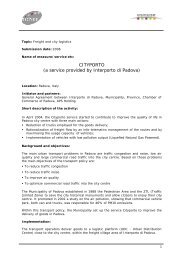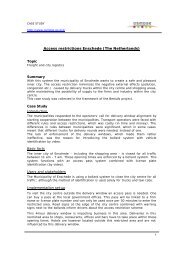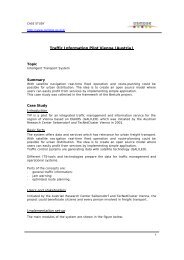Successful transport decision-making - Osmose
Successful transport decision-making - Osmose
Successful transport decision-making - Osmose
You also want an ePaper? Increase the reach of your titles
YUMPU automatically turns print PDFs into web optimized ePapers that Google loves.
FS 3: Management of information<br />
Vol 2 - Table of Contents <br />
Next<br />
<br />
T1<br />
Managing information<br />
Information is the key factor in delivering a successful <strong>transport</strong><br />
project. If the correct information is not available at the right<br />
time and of suitable quality, then poor <strong>decision</strong>s are likely to<br />
result.<br />
The management of information is about identifying, obtaining,<br />
processing, storing and exchanging all types of information<br />
needed during the project. This includes technical data, legal<br />
regulations and stakeholder views. The exchange of<br />
information will make use of different channels (discussion, e-<br />
mail, minutes, letters, etc.) and serve various purposes (e.g. to<br />
help make a <strong>decision</strong>, or to inform stakeholders).<br />
In order to maintain an overview and maximise efficiency, a<br />
central interface is needed where all information sources come<br />
together, both for project management and stakeholder<br />
engagement.<br />
Managing information for projects<br />
The main elements of information management are the same<br />
in each project:<br />
(1) Identify information needs: which information for whom,<br />
when, for which purpose, at what level of quality?<br />
(2) Check availability of different types of information;<br />
(3) Develop a strategy for the collection, processing, storage,<br />
and exchange of information (see FS 35: Data collection<br />
and data storage); and<br />
(4) Prepare a detailed plan of tools, procedures, timing, and<br />
responsibilities. Include a procedure to ensure that<br />
everybody receives and understands the relevant<br />
information.<br />
Managing information for engagement<br />
This lies at the interface between information management and<br />
engagement planning. In determining the information needs for<br />
engagement, the following questions should be addressed:<br />
<br />
<br />
<br />
Who are the relevant stakeholders? - both those who are<br />
involved in the <strong>decision</strong>-<strong>making</strong> process and those who are<br />
affected by the construction or implementation of the project.<br />
What information needs to be obtained from the various<br />
stakeholder groups, in which form, at what stage in the<br />
process, and how will it inform/modify the planning process?<br />
What information should be provided to different stakeholder<br />
groups, when and in which ways (e.g. announcements,<br />
events, etc.)?<br />
In the ongoing project management process, the role of<br />
information management should be to provide a continual and<br />
consistent link between planning and engagement activities.<br />
Managing information throughout the<br />
project<br />
An information management strategy must be developed before the<br />
project starts, as information will be required at the outset. Take into<br />
account all the information required to manage the progress of the<br />
project, to prepare for formal <strong>decision</strong> taking, as well as the cross links<br />
between the planning and engagement activities: which information is<br />
to be passed onto external stakeholders and what information is<br />
required from them? This results in an inward and outward flow, as<br />
shown in the figure.<br />
External groups<br />
External<br />
information<br />
Inward<br />
flow<br />
Outward<br />
flow<br />
Project team<br />
Internal<br />
information<br />
Managing information for project control<br />
In the planning process, three different kinds of information are<br />
needed:<br />
(1) Planning information required to plan the process and its<br />
outcome (ie the <strong>transport</strong> measure). It includes contextual<br />
constraints such as legal regulations and resources, further a<br />
problem description in technical terms, the characteristics of the<br />
options generated, impact scenarios, stakeholder attitudes,<br />
planning guidelines, etc. Some information can easily be<br />
collected (e.g. legal regulations), others will require<br />
considerable effort to gain it, e.g. an inspection on site, a travel<br />
behaviour model, or a social survey. (2) Control information<br />
that enables informed managerial <strong>decision</strong>s in line with the<br />
objectives of the project. The project manager must be informed<br />
of whether tasks actually meet plans and if resources are used<br />
efficiently. It requires a sound tracking of the progress (see<br />
FS34: Tracking progress). (3) Operational information needed<br />
for everyday work, e.g. financial accounting, control and<br />
scheduling. It relates to specific tasks and is usually exchanged<br />
internally, often in a verbal form.<br />
NOTES<br />
<br />
10


